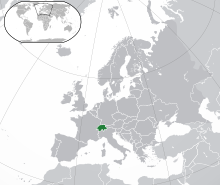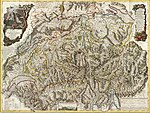Modern history of Switzerland
This article needs additional citations for verification. (February 2017) |
Swiss Confederation Five official names
| |||||||
|---|---|---|---|---|---|---|---|
| 1848–present | |||||||
| Anthem: Various
| |||||||
 Location of Modern history of Switzerland (green) in Europe (green and dark grey) | |||||||
| Capital | 46°57′N 7°27′E / 46.950°N 7.450°E | ||||||
| Largest city | Zürich | ||||||
| Official languages | |||||||
| Religion |
| ||||||
| Demonym(s) | |||||||
| Government | Federal assembly-independent[2][3] directorial republic with elements of a direct democracy | ||||||
| First:
Current:
| |||||||
| Johann Ulrich Schiess (first) Viktor Rossi (currently) | |||||||
| Legislature | Federal Assembly | ||||||
| Historical era | Modern era | ||||||
• Creation of the Swiss Federal Constitution | 12 September 1848 | ||||||
| 1914–1918; 1939–1945 | |||||||
• Dissolution of the 1848 constitution | 1 January 2000 | ||||||
| 25 February 2020 | |||||||
| Area | |||||||
• Total | 41,285 km2 (15,940 sq mi) (132nd) | ||||||
• Water (%) | 4.34% | ||||||
| Population | |||||||
• Estimate | 8,902,308[4] | ||||||
• 2002 | 1.28 billion | ||||||
| Currency | +41 | ||||||
| ISO 3166 code | CH | ||||||
| Internet TLD | |||||||
| |||||||
| History of Switzerland |
|---|
 |
| Early history |
|
| Old Swiss Confederacy |
|
| Transitional period |
|
| Modern history |
|
| Timeline |
| Topical |
|
|
|
This article deals with the history of Switzerland since 1848.
See
Formation of the Federal State (1848)
Following a 27-day civil war in Switzerland, the
Industrialisation and economic growth (1848–1914)
From 1847 to 1914, the
. TheThe
Banking emerged as a significant factor in Swiss economy with the foundation of the Union Bank of Switzerland in 1862, and the Swiss Bank Corporation in 1872.
The Golden age of alpinism in the 1850s to 1860s lay the foundation to the tourism industry.
World wars (1914–1945)
During
During World War I, Switzerland was situated between the
1945 to present
Government
From 1959, the
Women were granted the
During the
Domestic
In 1979, parts of the Bernese Jura attained independence while remaining in the Federation, forming the new canton of Jura.
The
Relations with the European Union
With the exception of Liechtenstein, Switzerland has been completely surrounded by the European Union since 1995. Swiss-EU relations are a major issue in the country.
Swiss voters narrowly rejected a December 1992 referendum to join the European Economic Area, with 50.3% of voters opposed. Swiss voters rejected EU membership in a March 2001 referendum, with 76.8% opposed.
Despite Swiss opposition to joining the EU, voters have accepted
In February 2014, Swiss voters approved
Switzerland co-founded the European Free Trade Association in 1960, which is a parallel organization to the EU.
Notes and references
- S2CID 178237847.
Als 1848 ein politisch-administratives Zentrum für den neuen Bundesstaat zu bestimmen war, verzichteten die Verfassungsväter darauf, eine Hauptstadt der Schweiz zu bezeichnen und formulierten stattdessen in Artikel 108: "Alles, was sich auf den Sitz der Bundesbehörden bezieht, ist Gegenstand der Bundesgesetzgebung." Die Bundesstadt ist also nicht mehr und nicht weniger als der Sitz der Bundesbehörden.
[In 1848, when a political and administrative centre was being determined for the new federation, the founders of the constitution abstained from designating a capital city for Switzerland and instead formulated in Article 108: "Everything, which relates to seat of the authorities, is the subject of the federal legislation." The federal city is therefore no more and no less than the seat of the federal authorities.] - S2CID 73642272.
- JSTOR 26300453.
- ^ "Bevölkerungsstand am Ende des 2. Quartals 2023 | Bundesamt für Statistik". 20 September 2023. Archived from the original on 20 September 2023. Retrieved 20 September 2023.
- ^ Country profile: Switzerland UK Foreign and Commonwealth Office, Retrieved on 2009-11-25
- ^ 7.4 States Formerly Possessing or Pursuing Nuclear Weapons Retrieved March 6, 2014
- ^ "Historical Outline on the Question of Swiss Nuclear Armament". Retrieved 8 December 2015.
- ^ Swiss nuclear bomb International Physicians for the Prevention of Nuclear War October 9, 2010. Retrieved March 6, 2014
Further reading
- Bonjour, E., H. S. Offler, G. R. Potter. A Short History of Switzerland (1952) online
- Church, Clive H., and Randolph C. Head. A Concise History of Switzerland (Cambridge University Press, 2013). pp 132–61 online
- Codevilla, Angelo M. Between the Alps and a Hard Place: Switzerland in World War II and the Rewriting of History (2000) excerpt and text search
- Dawson, William Harbutt. Social Switzerland: Studies of Present-day Social Movements and Legislation (1897) 302 pp; with focus on social and economic history, poverty, labour online
- Fahrni, Dieter. An Outline History of Switzerland. From the Origins to the Present Day (8th ed. 2003, Pro Helvetia, Zürich).
- Lerner, Marc. A Laboratory of Liberty: The Transformation of Political Culture in Republican Switzerland, 1750–1848 (Brill, 2011).
- Luck, James Murray. A History of Switzerland. The First 100,000 Years: Before the Beginnings to the Days of the Present. SPOSS, Palo Alto CA. (1985)
- Lüthi, Barbara, and Damir Skenderovic, eds. Switzerland and Migration: Historical and Current Perspectives on a Changing Landscape (Springer, 2019).
- Oechsli, Wilhelm. History of Switzerland, 1499–1914 (1922) full text online
- Schelbert, Leo. Historical Dictionary of Switzerland (2007) excerpt and text search



